Abstract
Information technologies play an important role in designing new ways of teaching, and, at the same time, the globalization of the business world affects the quality of human capital that the corporate sector requires. Apart from theoretical business understanding, multidisciplinary knowledge is also needed. Business simulation games belong among suitable educational tools, which are able to respond to contemporary business requirements and the requirements of students. Business simulation games provide a useful tool for experiential learning by university students studying business programs. For the effective development of students’ competencies in economic and managerial fields of study, it is necessary to apply appropriate steps in the implementation of simulation games and to understand the experience of students in the use of games in the teaching process. For that purpose, best practice for business simulation games has been determined. This introduced best practice includes description of the benefits from realized simulation games, from the lecturer point of view. A realized survey focused on the main benefits considered by students who completed the subject Managerial Simulation Game. The students’ approach to the implemented simulation games was gradually monitored over the course of five academic years. Research samples contain 148 students from the first year of a master’s study program. Our survey showed that the subject is more beneficial for students for their further study than for their future professions. At the same time, the vast majority of students perceive simulation games as a useful and interesting way to verify the dependencies between economic variables. To strengthen analytical skills, it is necessary to introduce tasks that support working with economic data through simulation games. The novelty of the paper consists of mapping the benefits from the implemented simulation games for the student’s own person, categorizing the identified benefits into six groups with the same characteristics, and, at the same time, implementing the research for students attending private and public schools.
1. Introduction
Information technologies play an important role in designing new ways of teaching university students in the field of education of with an economic-managerial focus [1], but also in acquiring the competencies of students at technological universities offering study programs such as mechanical engineering [2]. Students’ personalities are formed with respect to flexible communities that require direct connections with others in the community, quick responses, including social interaction, and a preference for experience-based learning [3]. Students prefer more interesting, fun, and motivating methods of learning to gain experience over conventional learning methods, which are based on absorbing information rather than working with knowledge, considering that information is important but fleeting. Learning from direct experience through action, and seeing the consequences of that action, seems to have the strongest impact.
As far as university education is expected to prepare students for a successful career in the area of business and economics, it is necessary to use innovative teaching approaches [4,5]. Educational computer games, referred to as serious games, belong to the educational tools that are able to respond to the requirements and needs of students. The games are based on an individual approach to individual students (student-centered-learning) and experiential learning [6] define serious games as a mental training with the help of a computer game with specific rules, which uses fun game elements for further education in various sectors in the public and private spheres. Serious games offer motivating and engaging experiences, an interactive learning environment, and joint learning activities [7]. The pedagogical approach of utilizing digital educational games is called digital game-based learning, which can be described as the “coming together” of interactive entertainment and serious learning through digital games [3]. Game-based learning is an innovative learning approach based on the use of computer games, which has educational value and leads to improved teaching and student assessment [8,9]. Augmented reality game-based learning belongs to a newly developing direction in education.
The serious-game group includes a business simulation game [10] and theory-based games such as prisoner–dilemma simulations, enterprise ERP simulations [5], and training in manufacturing and supply processes [11]. Theory-based games deal with conflict situations that can be represented by mathematical models. In contrast, business simulation games deal with the solution of the decision-making process, which has a precisely defined structure, while the basic elements are the participants of the game, the rules, and a set of data showing the course of the real process. For students of economics and management, computer business simulations are an effective teaching tool that support a holistic approach to the problem. The teaching process is activated and useful feedback is provided between the implemented activities of the student and their results [12,13]. At the same time, students learn to communicate with other team members through the game and learn to gain the support of other team members to implement their decision. Business simulation games fully confirm Comenius’ challenge “schola ludus—school as a play”.
Although a number of studies have shown the effectiveness of a BSG in acquiring economic and managerial competencies in university students [14,15], the application of simulation games in the teaching of university students is not a matter of course at universities with an economic-managerial focus [16]. At the same time, BSGs do not provide best practice from the implementation of a BSG from the pedagogue’s point of view, to ensure an effective teaching process and its incorporation into the teaching process. This means that the use of a BSG has become a common practice in the education of university students with economics and management education. They also do not deal with the individualization of the benefits resulting from the implementation of a BSG for a particular student or the subsequent response to the relevant findings by the teacher.
The aim of the paper is to define best practice, for the use of business simulation games in the teaching process in higher education with a business focus, regarding the steps implemented by students and game strategies. The use of a BSG in the taught course Management Simulation Game at the Moravian Business College Olomouc and the Faculty of Economics at the VSB-Technical University of Ostrava will be evaluated. Based on quantitative research, students’ satisfaction with the subject Managerial Simulation Game will be determined. At the same time, the usefulness and interest of verifying the dependencies between economic variables will be described. The benefits resulting from the implementation of simulation games for the student will also be identified through realized research [17]. Subsequently, changes and improvements in the teaching process of simulation games will be proposed. The novelty of the paper consists of mapping the benefits from the implemented simulation games for the student’s own person, categorizing the identified benefits into six groups with the same characteristics, and, at the same time, implementing the research for students attending private and public schools.
2. Use of Business Simulation Game in Business Education
2.1. Determination of Business Simulation Game and Its Benefits
Business simulation games are an effective tool for gaining experience in business education at universities with an economic-managerial focus. According to [18], business simulation games provide an effective learning environment that allows reflexive observation and experimentation through interactive decision-making and learning by trial-and-error. Within a business simulation game, participants face decision-making situations in a real environment. At the same time, students overcome challenges by developing the ability to make quick and effective decisions and to anticipate consequences and future developments. Business simulation games can be compared to management labs as tools for behavioral experiments [19]. When implementing a business simulation game, students lead a discussion, sometimes even argue, and try to predict the decisions of other competing teams in order to win the game. According to [20], there are two main features of learning outcomes. First, the computer-based learning game promoted students’ self-reflection and evaluation of their individual team roles. Second, although the game taught students the importance of continuous information sharing for teamwork, their evaluation of team outcomes was performance-driven, so students predominantly took team efficiency as a sign of good teamwork. A recent survey [21] showed that students responded better to learning with the use of practice enterprise (game-based learning) than to classical lectures methods.
Memorizing facts and acquiring ready-made knowledge have gradually been replaced by experiential learning [22]. In the field of experiential learning (ELT) [23], it is necessary to point out the relationship between practical experience and effective education. The authors have advocated that it is better for students to come into direct contact with the reality they were studying, instead of just reading, talking, and listening about it. The relationship between the used teaching method and the effectiveness of teaching was defined by [24], in the form of a cone of experience. The experience cone shows that we remember up to 90% of what we say and do, provided we are actively involved in real activities related to imitating experiences and giving presentations [25]. Kolb developed a model of experiential learning, called Kolb’s Learning Cycle. The starting point of learning is the student’s immediate concrete experience with the world and with themself. The student perceives the experience, observes and thinks about it, and thinks about themself from various points of view. The result of the reflection is the conceptualization of the problem on an abstract level, and the formation of concepts, theories, and hypotheses. This is followed, firstly, by active experimentation, which brings a new experience, secondly, by reflection, and so on. The process of a student forming knowledge is not a linear process, but a cyclical process, sometimes also called an endless learning spiral.
Additionally, numerous benefits were stated by [26], resulting from enriching curricula with business simulation games to develop undergraduate students’ abilities to manage business, which led to them experiencing other indirect advantages, such as effective group work, shared responsibility, and understanding of the business environment, as well as multi-dimensional long- and short-term planning. Nevertheless, not all the students used the full potential of the simulation game [27] states that business simulation games can improve students’ motivation to learn and their performance in the learning process.
Business simulation games are either focused on a specific functional area, e.g., they simulate the effect of price on demand, or they imitate all functional areas of the company, e.g., they integrate marketing, finance, logistics, and other areas in one game [28]. Business simulation games allows students to examine the economic system on a model [29,30] and fairly reliably to simulate the course and results of economic processes. Simulation models are able to include a number of specifics of complex social systems, e.g., feedback, delay, or nonlinearity [31]. Simulation models create interactive learning environments through which various experiments that are not feasible in real time can be performed. Simulation models can be used for the analysis of and testing of the impacts of different scenarios, strategies, etc.
Business simulation games deal with a solution for the decision-making process, which has a precisely defined structure, while its basic elements are people (participants in the game), rules, and a set of data showing the course of the real process. Business simulation games include simulation, resp. an activity that mimics reality, a game in which people agree to follow rules to achieve a desired state or goal. A simulation game allows participants to make decisions in a real economic environment. Due to their intentions, actions, and interactions with competitors, players are the ones who create an ever-changing market. The process of strategic thinking forces participants to go far beyond solving an immediate problem and forces them to consider future developments and how they want to influence it. Each decision period represents a new case, with a new set of circumstances. Implementation of simulation games [32] in business education enables the analysis and solving of complex problems, supports strategic thinking, emphasizes implementation of experience from various disciplines, supports implementation of own decisions, supports coping with consequences, allows responses to competition and its counterweights, verifies the ability to act in stressful situations, and represents a means of training. In contrast, alternative teaching approaches place little emphasis on qualitative thinking, complex outcomes, implementation, creativity, and long-term success, and place very little emphasis on corporate governance activities and risk-taking, while not they fail to pay sufficient attention to interpersonal relationships, social ethics, and a number of solutions for interconnected problems and management. Alternative teaching approaches include case studies that do not support students to make decisions, face the consequences, and respond to the moves and countermanoeuvres of the competition [33] They also do not support comprehensive problem solving, risk-taking and interpersonal skills training [34].
Business simulation games represent a teaching method that develops communication and interaction skills within a small group and develops analysis and self-analysis skills in a group-reflection process [2]. Moreover, according to a research study, the implementation of a BSG has a positive impact on behavioral involvement, cognitive involvement, critical-thinking development, and creativity, which will ultimately result in better academic performance for business students [14]. These findings are confirmed by another research study [35], which also points out the positive impact of a BSG on the development of marketing skills and a positive perception of learning. Teachers of economics courses ought to prepare students for life, when they take a more pluralistic approach to course content and pedagogy. Thus, understanding learning theory as integral to achieving desired outcomes is essential [36].
At the same time, the results of research studies [37,38] show that in the context of management education, business simulation games are increasingly emerging as pedagogical tools for motivating and actively involving students in teaching, enabling students to enter a state of flow. Flow is a mental state in which students are immersed in the desired activity and do not perceive anything else.
Research studies and literary sources show that simulation games in teaching university students in the field of business education are primarily an effective means of gaining experience, creating interactive learning environments, solving decision-making processes, and supporting critical and strategic thinking, and they are also an effective tool for motivation and student involvement in learning.
2.2. Characteristics of Business Simulation Games
Business simulation games have a team character. It is usually based on the participation of a certain number of teams, and each team has a certain number of players. Within each team, it is important to appoint a team leader, who takes responsibility for implementing decisions and communication within the team. Simulation games take place in phases, respectively in individual rounds, though their number depends on the type of scenario in an individual game or on the type of game. Often, one round represents one quarter or one month. Each round begins with the evaluation of information about the company and competitors, followed by a decision within the individual parameters and the decision being entered into the simulation. At the end of the round, the teams receive information about the company and the industry. During the implementation of a simulation game, there is an interaction that has a dual character. Firstly, the interaction takes place between the members of each team within the different levels of decision-making, and secondly, between the individual teams. The simulation game provides feedback by capturing the immediate economic consequences of individual team decisions. Based on reports on economic results, it enables individual teams to provide feedback. It follows that the simulation game has a team and phase (stage) character and is based on interaction and feedback.
3. Best Practice of Using Business Simulation Game from the Lecturer Point of View
Currently, the managerial simulation games JA TITAN and UNISIM are used in teaching the subject Managerial Simulation Game at Moravian Business College Olomouc, where students gain practical experience in managing a virtual company on the basis of previous knowledge. The selected simulation games JA TITAN and UNISIM are used in teaching due to good experience with technical implementation, the range of required knowledge, and affordability. The simulations complement each other: the JA TITAN simulation focuses primarily on gaining experience in managing a manufacturing company, and UNISIM focuses on gaining experience in managing a company that sells electronic products. In addition, the JA TITAN simulation was one of the first simulations in the Czech Republic to be offered for educational purposes.
These two simulation games are accessible after logging into the web interface. Simulation games have their specifics, which differ from each other, especially in decision parameters (decision levels), in graphical options (use of graphs in decision-making), in the chosen product commodity, and in the price of acquisition of the particular simulation.
3.1. Procedure Steps for the Implementation of a Business Simulation Game
When implementing a business simulation game, the moderator (pedagogue) plays an important role. They provide students with theoretical input when moving to a new level of difficulty, implement practical exercises in the field of decision-making, and manage the time course of the game. The game moderator also delivers and comments on the final reports and evaluates the teams according to the set criteria at the end of the game. Business simulation games are realized by their subsequent steps—see Figure 1. Each step of the game is part of an endless learning spiral through which students acquire economic and managerial knowledge.
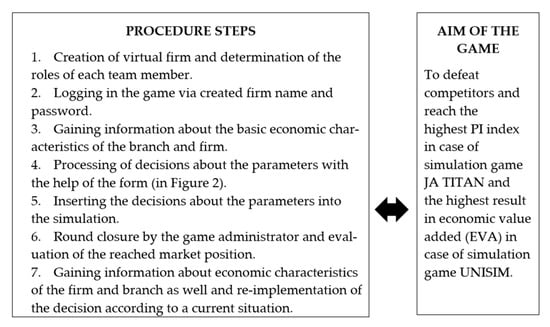
Figure 1.
Students’ steps within business simulation game.
The students’ correct decision-making in the individual steps in simulation games is supported by elaborated methodological instructions, which are inserted into the information system before each seminar, within the interactive syllabus of the subject, as shown in Figure 2. The instructions contain the individual steps that students must solve before changing the economic parameters in the simulation.
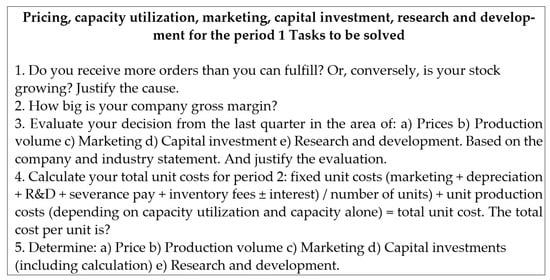
Figure 2.
Sample methodological guidelines.
3.2. Business Simulation Game JA TITAN
JA TITAN is a computer simulation that allows student teams to manage fictitious companies and compete with each other in the production and sale of a fictitious product, called a “halogen generator”. It is a device used to create holographic images. Implementation of the simulation game is based on students’ teamwork. Each team must have at least two students. Before the game begins, students create a virtual company, establish management, and determine the roles that each member will have. Eight virtually created companies can participate in each game. The goal of the management teams is to manage virtual companies, so that they achieve the highest performance index points (PI index). It is an index reflecting the value of the company’s shares on the market (the so-called stock index). The PI index includes six business factors (total profit, supply potential, demand potential, productivity, growth, market share), which are important for evaluating a company’s performance. Since, at the beginning of period 0, all these factors are equal for individual companies, companies begin with the same performance index (100)—see Table 1.

Table 1.
Structure of PI index.
When managing a virtual company, a team of students decides on economic parameters, such as the price, the size of the amount produced, amount of marketing expenses, capital investments, research and development, and charity expenses, as shown in Figure 3.
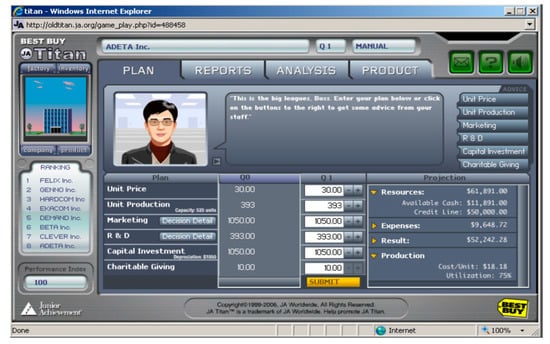
Figure 3.
Initial screen in JA TITAN simulation game.
In their decision-making, student teams must take into account the simulated situation of the business environment and the economic scenario. The simulation game JA TITAN has the option of setting seven scenarios: standard, product introduction, industry innovation, full business cycle, global competition, product obsolesce, and economic recovery.
The decisions made by individual teams are automatically evaluated after each round, indicating the order of the competing teams according to the achieved PI index. The number of rounds for each scenario varies. The basis for correct team decision-making is the company report, which reports on and provides information about the economic situation in the company. An industry report provides an overview of the state of the entire industry and compares the performance of individual student companies. The company report contains an abbreviated income statement with balance and cash flow and reports about production, marketing, and investment. During the simulation game, students verify the influence of economic parameters on the final result. Some of them have an immediate short-term effect such as a selling price, a long-term effect such as research and development, or a delayed long-term effect such as capital investment. The following Table 2 defines the advantages of the JA TITAN simulation game from the lecturer point of view.

Table 2.
Benefits of using business simulation game JA TITAN from the lecturer (pedagogue) point of view.
3.3. Business Simulation Game UNISIM
The business simulation game exists in two versions, which take place with different products and in different service markets, namely the consumer electronics market and the tourism market. Implementation of the simulation game is based on the teamwork of students. Each team consists of one to five players, with a min. of three and a max. of eight teams. Before the game begins, students create a virtual company, establish a management structure, and determine the roles of individual members. The goal of management teams is to manage virtual companies, so that they achieve the highest possible value of the economic value added (EVA) parameter. The economic value added (EVA) parameter is defined according to a formula [39]:
where EBIT—earnings before interest and taxes, t—tax charge per income, C—capital invested, NOPAT—net operating profit after taxes, and WACC—weighted average costs of capital.
EVA = EBIT × (1 − t) − C × WACC = NOPAT − C × WACC,
The decision-making success of student teams within the UNISIM simulation game can also be assessed on the basis of the ROE parameter or the number of sales.
When managing a virtual company, student teams make decisions within the following parameters:
- Types of products and their parameters, prices, and offered quantities;
- Types of communication, media plan, and frequency of communication;
- Types of business channels, their sales, and their numbers in regions;
- Internal company financing and outsourcing;
- Employee rewards and training;
- Decided parameters are inserted in the initial screen—see Figure 4.
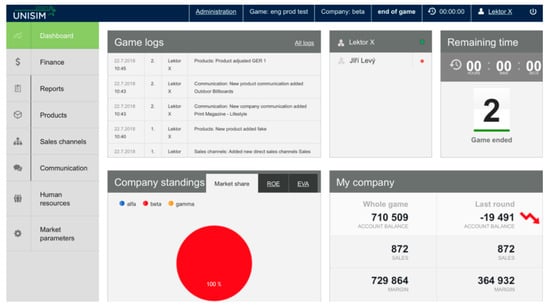 Figure 4. Initial screen in the simulation game UNISIM.
Figure 4. Initial screen in the simulation game UNISIM.
The Casual-Loop Diagram shows how the individual parameters are affected. It is a graphical representation and analysis of the mutual influences of variables that are part of the UNISIM simulation game model. Visualization of mutual relations of variables facilitates understanding of the function of complex systems and helps to quantify these relations. There are arrows between the individual parameters of the game, which indicate the dependence. The direction of the arrow indicates the direction of the dependence, as shown in Figure 5.
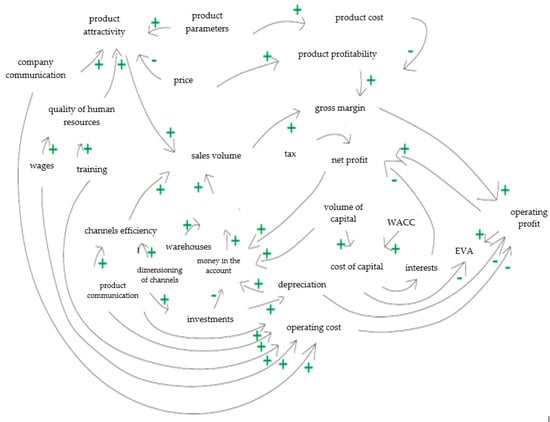
Figure 5.
CLD diagram of dependencies among individual parameters.
The decisions made by individual teams are automatically evaluated after each round, indicating the order of the competing teams according to the achieved parameter economic value added (EVA). The number of rounds is determined by the game moderator, and the recommended number of rounds played is 12, which represents one year of the company’s life.
The basis for correct team decision-making are the company report, which provides key information about the economic situation in the company, and the industry report, which provides an overview of the state of the entire industry and compares the performance of individual student teams. The company report contains an abridged income statement, balance sheet, and cash flow statement and reports of production, marketing, and investment.
For the benefits of the implementation of the UNISIM business simulation game from the lecturer’s point of view, see Table 3.

Table 3.
Benefits from the implementation of the UNISIM business simulation game from the lecturer’s point of view.
4. Students’ Approach to Realized Simulation Games in Education—Benefits from Implemented Simulation Games
The simulation games JA TITAN and UNISIM are used in the teaching of the subject Managerial Simulation Game at Moravian Business College Olomouc and the Faculty of Economics VSB-Technical University of Ostrava. The course is offered to students in their first year of master’s studies, within the study program Economics and Management at both universities. Students are expected to have necessary theoretical economic and managerial knowledge, which is needed to gain practical experience in managing a company through simulation games.
4.1. Design of the Research Survey
After completing the course Management Simulation Game, at the end of the semester students completed an anonymous online questionnaire, found in the IS of the university or in a Google form. Student responses were collected over five academic years (2016/2017—70 students, 2017/2018—50 students, 2018/2019—13 students, 2019/2020—2 students, 2020/2021—13 students). The total research sample is 148 full-time and part-time students. Students included in the research sample under the framework of the teaching of the Managerial Simulation Game used both simulation games, namely JA TITAN and UNISIM.
The questionnaire was the same for all periods and contained a total of 18 questions (8 questions for simulation games, 8 questions for the realization of the teaching process, and 2 identification questions). Open-ended questions were used in the questionnaire, leaving the respondent absolute freedom in expressing their answer, whilst at the same time some closed questions were also used. Within the closed questions, there were dichotomous questions, multiple selection (multiple choice) questions (polytomical) with enumeration or selection questions. The results of the research survey were evaluated with the use of the frequency of occurrence (absolute and percentage), including a graphical representation and categorization of verbal answers into appropriate groups [40]:
The aim of the research was to find out the perception of the benefits of the course Managerial Simulation Game for students, their further studies, and their future professions, evaluate the benefits and interestingness of verifying economic dependencies through simulation games and the prerequisites for obtaining a high PI/EVA index, and, at the same time, find out the greatest benefit of simulation games for each individual student. With regard to these research aims, the research questions were determined.
Research questions:
- How do students evaluate the benefits of the MSG course for further study? This was designed to find out the benefits of the MSG course for the needs of re-introduction or re-introduction into the study program.
- How do students evaluate the benefits of the MSG course for future professions? This was designed to verify the possibilities of usability of the MSG course for future professions such as business, entrepreneur, manager, etc.
- How do students evaluate the usefulness and interest of the method of verifying economic dependencies through simulation games? This was designed to map the usefulness of implemented games in teaching (JA TITAN, UNISIM) for the needs of a complex perception of dependence between economic variables, such as the effect of price on the number of orders, investment in research and development, and the impacts on profit and product quality.
- What is the main prerequisite for obtaining a high PI/EVA index? This was designed to find out the justification of the use of methodological procedures in order to achieve the highest possible value of PI. The student’s decision-making should be based to a greater extent on a quality analysis of the situation and to a lesser extent on intuition.
- According to students, what is the biggest benefit of simulation games for each of them personally? This was designed to find out students’ views on the benefits of a BSG for their own person and evaluate the answers into groups according to common characteristics.
Research methodology
The research methodology is shown in the Figure 6, including the concrete steps of realization.
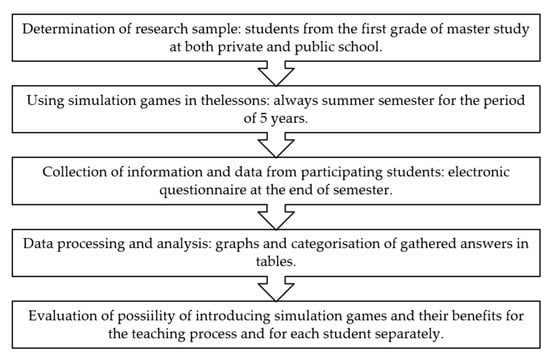
Figure 6.
Steps of the realization research.
4.2. Results of the Research Survey
The research survey showed that the subject Managerial Simulation Game is beneficial for further study for 62% of students and very beneficial for 20%. On the contrary, it is of little benefit to only 7% of students, and no student stated that the course does not bring them any benefit, as shown in Scheme 1.
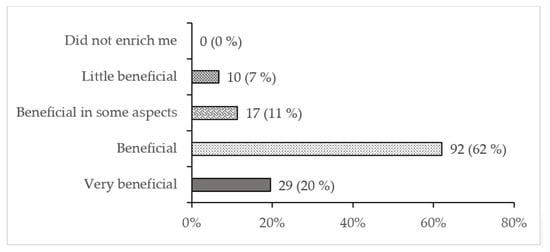
Scheme 1.
Contribution of the subject Management Simulation Game for further study.
At the same time, it was found that the subject Managerial Simulation Game is very beneficial for 10% of students and beneficial for 47% of students, as shown in Scheme 2. There are students (5%) who think that the subject does not bring them benefits, and 16% of students rate the subject as not very beneficial. The lower perceived contribution of the subject to future professions can be explained by the existence of part-time students who do not have to work in business, but in public institutions, where the experience gained from the subject is not so important.
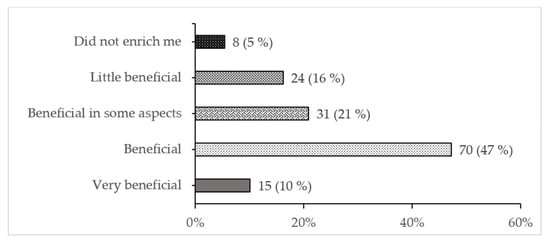
Scheme 2.
Contribution of the subject Management Simulation Game for future professions of students.
The vast majority of students (76%) stated that the simulation games implemented in the course Managerial Simulation Game helps them to verify the economic dependencies between individual variables such as price and cost, quantity produced and capacity utilization, etc., in a beneficial and interesting way. See Scheme 3.
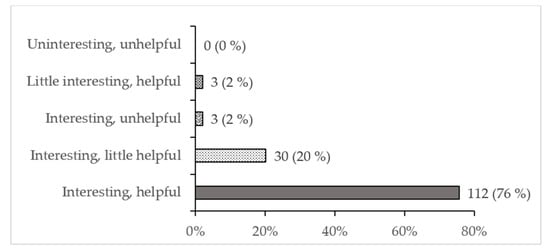
Scheme 3.
The benefits and interest levels of the way of verifying economic dependencies through a simulation game.
The game also allows students to recognize the effect of individual variables on the achieved result of the company (e.g., expenditure on research and development having a long-term effect, marketing expenditure immediate effect on the number of orders, etc.). Not a single student stated that verifying economic variables using simulation games is uninteresting and useless.
The results showed that students see the main prerequisite for obtaining a high PI/EVA index in the proven experience of previous rounds of the game (40%) and in good orientation in the financial statements (35%), as shown in Scheme 4. Surprisingly, more students (13%) trust their own intuition rather than their own calculations (5%). Some students (7%), who rely on the good advice of the moderator, also appear here.
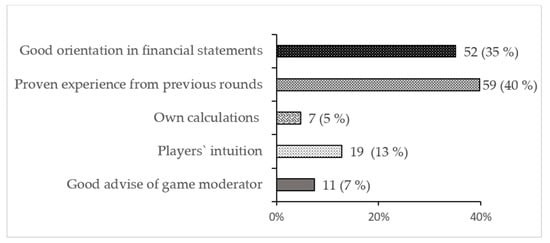
Scheme 4.
Main prerequisites for obtaining a high PI index or EVA indicator.
Up to 85% of students are inspired by the game moderator, whose aim is to create a competitive atmosphere. Only 15% of students do not value it.
Overall, 117 students out of a total of 148 respondents commented on the benefits of simulation games for the student’s own person, though 31 students did not comment. The answers obtained were categorized according to the same student-defined content and were included in groups. Of the 117 responses, 107 were classified into six groups, which were identified by the name of a common characteristic within the group. For each group, 5 answers were always selected for the sample, though 10 answers could not be included in the groups because 2 answers were negative, resp. simulation games were of no benefit to students, and 8 responses with the same content occurred less than three times. In these answers, the students considered following factors as beneficial: learning to take risks, motivation to compete, and finding out that they are not suited to becoming managers.
Group 1: Managerial experience—Students see the benefits of simulation games in a practical trial to manage a company and respond to the market situation, as shown in Table 4. The answers in this group occur the most, at 29.9%.

Table 4.
Selected answers from the first group of students.
Group 2: Understanding of the dependence between economic variables—Students in the answers emphasize a closer acquaintance with economic variables and knowledge of their mutual relations between them and the impact on the final result, as shown in Table 5. The answers in this group occur at 20.5%.

Table 5.
Selected answers from the second group of students.
Group 3: Teamwork—Students see the benefits of simulation games in the ability to learn to communicate in a team, enforce their views on decisions made in simulations, and make decisions based on compromise, as shown in Table 6. The answers in this group occur at 13%.

Table 6.
Selected answers from the third group of students.
Group 4: Business inspiration—The benefits of the simulation game are seen by the students in the opportunity to try out situations and activities related to business. It emphasizes the practical testing of activities implemented in a real company, including knowledge of the implemented processes, as shown in Table 7. Answers from 16.8% of students are included in this group.

Table 7.
Selected answers from the fourth group of students.
Group 5: Game and connection of theory with practice—The benefits are seen in learning through play and in the ability to link theory with practice through play, which is both fun and rewarding for students, as shown in Table 8. These benefits were defined by 10.2% of students.

Table 8.
Selected answers from the fifth group of students.
Group 6: Analytical skills and orientation in financial statements—Students see the benefit in supporting analytical skills, which are important not only in the implementation of decisions in a fictitious company in simulations, but especially in real business practice. At the same time, the simulations enabled them to orient themselves to financial statements, reports from marketing and production activities, and market research, as shown in Table 9. Answers from 9.3% of students are included in this group.

Table 9.
Selected answers from the sixth group of students.
5. Discussion
The simulation games JA TITAN and UNISIM differ in the simulated area, decision-making parameters, gained experience, and the way of measuring the achieved results of the company.
Best practice from the use of business simulation games JA TITAN and UNISIM is introduced from the lecturer’s point of view. The games are implemented according to defined process steps, which are repeated as an endless spiral of learning and lead to gaining experience in how to beat the competition and achieve the highest value of the PI index or economic added value. To support the implementation of individual steps, the teacher develops methodological instructions containing tasks for the students. Task processing leads students to the implementation of economic calculations and supports orientation in financial statements. The use of the simulation games JA TITAN and UNISIM in the teaching process supports the development of students’ competencies in the field of managerial skills, their analytical skills and orientation in economic variables, and the impact on the final results of the company. A research study describing the authors’ experience with the business simulation game TOPSIM General Management II (GM2) highlights the development of students’ competencies and identifies 21 competencies related to management, such as analytical thinking, strategic thinking, teamwork, goal definition, and opportunity recognition [41].
When implementing the game, the lecturer plays the role of moderator, who is responsible for providing instructions, completing rounds, evaluating the order in the game, and motivating students for better results. At the same time, the survey results showed that a competitive atmosphere motivates the vast majority of students to reach better performance levels. The importance of the game moderator in the implementation of simulation games is not emphasized in current research studies, despite the fact that their role is important in the process of developing students’ economic and managerial competencies. The moderator plays an important role in the areas of student motivator and support, in order to achieve better results.
The students’ approach to the implemented simulation games was monitored over the course of five academic years, always after completing the course Managerial Simulation Game, where the simulations are implemented. In total, 148 students represent the result of the realized survey. To achieve the goal of the research survey, the research questions were carefully designed and defined. The answers to the research questions were obtained within the research study. The research showed that the subject is significantly more beneficial for students for further study than beneficial for future professions. At the same time, the vast majority of students (76%) perceive simulation games as a useful and interesting way to verify the dependencies (and relationships) between economic variables. Experiences from previous years (40%) and good orientation in financial statements (35%) were perceived by the students as the most important factors for reaching the highest index PI/EVA. Even in the partial analyses for each year during 2016–2021, it was found that the results do not differ significantly and can be agreed with the research study “Attitudes and skills of generations do not change over time and the skills and knowledge that simulations convey can be considered constant throughout the period” [42].
The evaluation of the benefits that were noticed by the students while realizing a BSG was analyzed and classified into six groups, according to the same characteristic features. The frequency of occurrence of individual opinions for individual groups is given in a summary in Table 10 and commented on, as shown in the discussion in the article.

Table 10.
The frequency of occurrence of individual opinions for individual groups.
The realized survey showed that students see the greatest benefit for themselves in gaining managerial experience (29.9%), followed by an understanding of the dependencies between economic variables (20.5%) and an inspiration for business (16.8%). Students find the least importance in supporting analytical skills and orientation in financial statements (9.3%). The perception of benefits in the form of strengthening the ability to work in a team (13%) and to enforce one’s opinions and make decisions based on compromise is also not negligible. It is interesting that students attach greater importance to the acquisition of competencies in the field of managerial experience and the understanding of the relationship between economic variables. In contrast, the development of analytical skills through simulation games is not positively perceived by students from the perspective of the teacher (game moderator), which is also documented in research studies [14,35,41,43].
Experience from the applied simulation games UNISIM and JA TITAN from the pedagogue’s point of view and the research results from the students’ point of view point to the need to strengthen students’ analytical skills through specific tasks that students will perform in simulation games. The tasks will be part of the methodological guidelines that will support the search for data in financial statements and the search for the impact of economic variables on the company’s results. Emphasis must be placed on the verbal interpretation of data in methodological guidelines and the introduction of student participation, in evaluating the results achieved by all companies in the industry, together with the teacher. At the same time, it is necessary to focus on finding out the reasons for the low perception of the importance of simulation games in the development of analytical skills and teamwork, through action research on a selected sample of students. On the other hand, the research results point to the positive effect of simulation games on inspiration for business, especially when starting a business. This results in another possible way of utilizing a business simulation game, not only in teaching, but also in business incubators as part of consulting activities when starting a business.
The limitation of the research lies in the size of the research sample, which is dependent on the number of registered students for the compulsory elective subject in the relevant academic year. New or future research in this area should focus on identifying appropriate tools to support analytical skills and the ability to navigate financial statements. This is because this benefit resulting from the implementation of a BSG occurred with the least frequency in the research study of the aforementioned students.
6. Conclusions
Business simulation games play an important role in digital education and in the active educational process of university students with a business focus. Business simulation games belong to methods of experiential learning and represent part of digital educational games enabling digital learning. Business simulation games allow students to get to know the economic laws of the company and the market through a game. This is confirmed by the results of research that show that teaching and learning processes in management courses using business simulation games draw on innovative elements, which examine the complexity of decision-making processes and offer an effective and pleasant learning environment [44].
Although the JA TITAN and UNISIM simulation games were not primarily developed for the purpose of education in the field of sustainability, they meet the basic principles that education for sustainable development requires. This requires a new learning culture based on participatory processes and new teaching techniques [45] as well as resp. use of action and experiential learning methods, which include simulation games. Previous research has mainly mapped the use of simulations and games in specific thematic areas of sustainability, such as energy, climate change, and natural resource management, but in recent years simulations and games have been mapped to the thematic focus on environmental, economic, and social sustainability. They are used mainly in the university environment [46].
A modern manager needs a number of professional competencies to be able to create a vision of the future related to the unique technical and economic characteristics of a particular industry. Business simulation games and simulation games focused on education for sustainability meet the principles of post-advanced education and the requirements for a new generation of educational programs [47].
Author Contributions
Conceptualization J.P.; Formal analysis Z.R.; Methodology J.P. and Z.R.; Project administration L.P.; Resources L.P.; Supervision J.P. All authors have read and agreed to the published version of the manuscript.
Funding
This article was created with the financial support of the ROKA project CZ.02.2.69/0.0/0.0/18_054/0014592, The Advancement of Capacities for Research and Development at Moravian Business College Olomouc.
Informed Consent Statement
Informed consent was obtained from all subjects involved in the study.
Conflicts of Interest
The authors declare no conflict of interest.
References
- Aranda, D.A. Simulating reality for teaching strategic management. Innov. Educ. Teach. Int. 2007, 44, 273–286. [Google Scholar] [CrossRef]
- Kadeeva, Z.K.; Kraysman, N.V.; Kadeeva, E.N. Using Business Games to Build Engineering Competencies in Technological University Students. Int. Conf. Interact. Collab. Learn. 2021, 390, 676–683. [Google Scholar] [CrossRef]
- Anastasiadis, T.; Lampropoulos, G.; Siakas, K. Digital Game-based Learning and Serious Games in Education. Int. J. Adv. Sci. Res. Eng. 2018, 4, 139–144. [Google Scholar] [CrossRef]
- Hughes, T.; Regan, N.; Wornham, D.; O’Regan, N. The credibility issue: Closing the academic/practitioner gap. Strateg. Change. 2008, 17, 215–233. [Google Scholar] [CrossRef]
- Beranič, T.; Heričko, M. The Impact of Serious Games in Economic and Business Education: A Case of ERP Business Simulation. Sustainability 2022, 14, 683. [Google Scholar] [CrossRef]
- Michael, D.; Chen, S. Serious Games: Games That Educate, Train, and Inform; Thomson Course Technology: Boston, MA, USA, 2006. [Google Scholar]
- Kaufman, D.; Sauvé, L. Educational Gameplay and Simulation Environments: Case Studies and Lessons Learned; IGI Global: Hershey, PA, USA, 2010. [Google Scholar] [CrossRef]
- Tang, S.; Hanneghan, M.; R. halibi, A.E. Introduction to Games-Based Learning. 2009. Available online: https://www.ipn.mx/assets/files/upiih/docs/SRI/c1.pdf (accessed on 19 April 2022).
- Basler, J.; Mrázek, M. Computer Games and Their Place in a Human Life; Univerzita Palackého: Olomouc, Czech Republic, 2018. [Google Scholar]
- Aldrich, C. The Complete Guide to Simulations and Serious Games; Pfeiffer: San Francisco, CA, USA, 2009. [Google Scholar]
- Schmuck, R. Education and training of manufacturing and supply chain processes using business simulation games 2021. Procedia Manuf. 2015, 55, 555–562. [Google Scholar] [CrossRef]
- Arnab, S.; Lim, T.; Carvalho, M.B.; Bellotti, F.; Freitas, S.; Louchart, S.; Suttie, N.; Berta, R.; Gloria, A. Mapping learning and game mechanics for serious games analysis. Br. J. Educ. Technol. 2015, 46, 391–411. [Google Scholar] [CrossRef] [Green Version]
- Goi, C.L. The use of business simulation games in teaching and learning. J. Educ. Bus. 2019, 94, 342–349. [Google Scholar] [CrossRef]
- Huang, Y.-M.; Silitonga, L.M.; Wu, T.-T. Applying a business simulation game in a flipped classroom to enhance engagement, learning achievement, and higher-order thinking skills. Comput. Educ. 2022, 183, 104494. [Google Scholar] [CrossRef]
- Wei, C.-L.; Wang, Y.-M.; Lin, H.-H.; Wang, Y.-S.; Huang, J.-L. Developing and validating a business simulation systems success model in the context of management education. Int. J. Manag. Educ. 2022, 20, 100634. [Google Scholar] [CrossRef]
- Januszewski, A.; Kujawski, J. Research concept of business simulation game application to management education in Poland. In Proceedings of the 26th Americas Conference on Information Systems, AMCIS 2020, Virtual Conference, 15–17 August 2020; Association for Information Systems, 2020. ISBN 978-173363254-6. [Google Scholar]
- Němec, J. Kapitoly ze Sociální Pedagogiky a Pedagogiky Volného Času Doplňující Pedagogické Studium; Paido: Brno, Czech Republic, 2002; p. 119. [Google Scholar]
- Vij, S.; Rajnish, S. Experiential Learning through Business Simulation Game in Strategic Management. In Proceedings of the 20th Annual Convention of Strategic Management Forum, Strategy, Innovation and Entrepreneurship Curriculum in the Era of Disruption, Indian Institute of Management Tiruchirapalli, Tiruchirappalli, India, 25–27 December 2018. [Google Scholar]
- Wolfe, J.; Castrovanni, G. Business Games as Strategic Management Laboratories. Dev. Bus. Simul. Exp. Learn. 2006, 33, 31–40. [Google Scholar]
- Riivari, E.; Kivijärvi, M.; Lämsä, A. Learning teamwork through a computer game: For the sake of performance or collaborative learning? Educ. Technol. Res. Dev. 2021, 69, 1753–1771. [Google Scholar] [CrossRef]
- Moca, M. Using Game Based Learning Elements in Practice Enterprises for Entrepreneurial Education. In Proceedings of the 15th European Conference on Game Based Learning, Romania; 2021. Available online: https://www.proquest.com/openview/0bb1a58c3aafd8969762e4c07e407f87/1?pq-origsite=gscholar&cbl=396495 (accessed on 19 April 2022).
- Vejvodová, L.; Rohlíková, J. Teaching Methods at University: Practical Guide to Teaching in Full-Time and Distance Form of Study; Grada: Praha, Czech Republic, 2012. [Google Scholar]
- Dewey, J. Experience and Education; Simon and Schuster: New York, NY, USA, 1938. [Google Scholar]
- Dale, E. Audiovisual Methods in Teaching; Dryden Press: New York, NY, USA, 1946. [Google Scholar]
- Kolb, D.A. Experiential Learning: Experience as the Source of Learning and Development; FT Press: Prentice-Hall, NJ, USA, 1984. [Google Scholar]
- Martínez, I.; Segura, A.; Tendero-Caballero, R.; Serrano-Pérez, B. Learning with business simulation games:factors influence undergraduate students outcomes. Strateg. Change. 2018, 17, 215–233. [Google Scholar] [CrossRef]
- Capelo-Badillo, S.; Hernandez, A.; Serradell, L.E. A Systematic Review on the Effectiveness of Business Simulation Games and Learning Performance. 2018. Available online: https://www.google.com.hk/url?sa=t&rct=j&q=&esrc=s&source=web&cd=&cad=rja&uact=8&ved=2ahUKEwja05Oqjor5AhVXfN4KHRUnAIwQFnoECAMQAQ&url=https%3A%2F%2Fwww.researchgate.net%2Fprofile%2FEnric_Serradell_Lopez%2Fpublication%2F326715431_A_SYSTEMATIC_REVIEW_ON_THE_EFFECTIVENESS_OF_BUSINESS_SIMULATION_GAMES_AND_LEARNING_PERFORMANCE%2Flinks%2F5f7dcec0299bf1b53e141432%2FA-SYSTEMATIC-REVIEW-ON-THE-EFFECTIVENESS-OF-BUSINESS-SIMULATION-GAMES-AND-LEARNING-PERFORMANCE.pdf&usg=AOvVaw1pzBkB4LXDvDq3wbmelWeq (accessed on 19 April 2022).
- Washbush, J.B.; Gosen, J. Total enterprise simulation performance and participant learning. J. Workplace Learn. 1998, 314–319. [Google Scholar] [CrossRef]
- Častoral, Z. Strategic Knowledge Management and Learning Organization; Vysoká Škola Finanční a Správní: Praha, Czech Republic, 2008. [Google Scholar]
- Sterman, J. Business Dynamics: Systems Thinking and Modeling for a Complex World; McGraw-Hill-Irwin: Boston, MA, USA, 2000. [Google Scholar]
- Ritterfeld, U.; Cody, M.; Vorderer, P. Serious Games: Mechanism and Effects; Routledge: New York, NY, USA, 2009. [Google Scholar]
- Mildeová, S. Creation of Management Simulators–Your Virtual Company; Oeconomia: Praha, Czech Republic, 2007. [Google Scholar]
- Powell, S. Case Management: A Practical Guide for Education and Practice; Lippincott Williams & Wilkins: Philadelphia, PA, USA, 2009. [Google Scholar]
- Fotr, J.; Hrůzová, H. Case Studies of Managerial Decision Making and Managerial Games; VŠE: Praha, Czech Republic, 1996. [Google Scholar]
- Skinner, E.A. Engagement and disaffection as central to processes of motivational resilience and development. In Handbook of Motivation at School, 2nd ed.; Routledge: New York, NY, USA, 2016; pp. 145–168. [Google Scholar] [CrossRef]
- Peterson, J.; MrGoldrick, K.M. Pluralism and Economic Education: A Learning Theory Approach. Int. Rev. Econ. Educ. 2009, 8, 72–90. [Google Scholar] [CrossRef]
- Bitrián, P.; Buil, I.; Catalán, S. Flow and business simulation games: A typology of students. Int. J. Manag. Educ. 2020, 18, 100365. [Google Scholar] [CrossRef]
- Buil, I.; Catalán, S.; Martínez, E. Encouraging intrinsic motivation in management training: The use of business simulation games. Int. J. Manag. Educ. 2019, 17, 162–171. [Google Scholar] [CrossRef]
- Kislingerová, E. Manažerské Finance. 3. vyd.; C.H. Beck 2010, Beckova edice ekonomie: Praha, Czech Republic, 2010; ISBN 978-80-7400-194-9. [Google Scholar]
- Hendl, J. Kvalitativní Výzkum: Základní Teorie, Metody a Aplikace. 2. Přeprac. a Aktual. Vyd; Portál: Praha, Czech Republic, 2008; p. 408. ISBN 978-80-7367-485-4. [Google Scholar]
- Mustata, I.C.; Alexe, C.G.; Alexe, C.M. Developing competencies with the general management II business simulationgame. Int. J. Simul. Model. 2017, 16, 412–421. [Google Scholar] [CrossRef]
- Kiss, T.; Schmuck, R. A Longitudinal Study of the Skills and Attitudes Conveyed by Two Business Simulation Games in Pécs, Hungary. Simul. Gaming 2021, 52, 435–464. [Google Scholar] [CrossRef]
- Anderson, P.H.; Lawton, L. Business simulations and cognitive learning: Developments, desires, and future directions. Simul. Gaming 2009, 40, 193–216. [Google Scholar] [CrossRef]
- Butzke, M.A.; Alberton, A.; Schmitt, T.; Marinho, S.V. Business simulation games as an active learning teaching methodology: Students’ perceptions. Int. J. Innov. Learn 2021, 30, 462–483. [Google Scholar] [CrossRef]
- Gatti, L.; Ulrich, M.; Seele, P. Education for sustainable development through business simulation games: An exploratory study of sustainability gamification and its effects on students’ learning outcomes. J. Clean. Prod. 2019, 207, 667–678. [Google Scholar] [CrossRef]
- Hallinger, P.; Wang, R.; Chatpinyakoop, C.; Nguyen, V.T.; Nguyen, U.P. A bibliometric review of research on simulations and serious games used in educating for sustainability, 1997–2019. J. Clean. Prod. 2020, 256, 120358. [Google Scholar] [CrossRef]
- Gitelman, L.; Kozhevnikov, M.; Ryzhuk, O. Advance Management Education for Power-Engineering and Industry of the Future. Sustainability 2019, 11, 5930. [Google Scholar] [CrossRef] [Green Version]
Publisher’s Note: MDPI stays neutral with regard to jurisdictional claims in published maps and institutional affiliations. |
© 2022 by the authors. Licensee MDPI, Basel, Switzerland. This article is an open access article distributed under the terms and conditions of the Creative Commons Attribution (CC BY) license (https://creativecommons.org/licenses/by/4.0/).